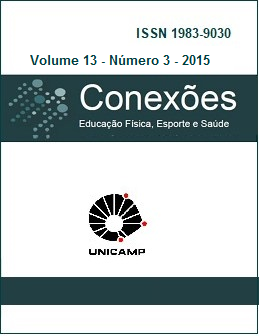Abstract
The scientific literature has formulated several theories, publications and academic debates
used as a backdrop, in the school universe. Reflecting on inequalities and promote social
inclusion is one of the challenges for the educators proposed by science. The objective of
this study was to determine if there are differences in fitness among boys and girls in
primary education. Methodology: Data were collected from 44 children with a mean age of
8.65 (± 0.6) years, 22 males and 22 females. We measured weight (kg), height (m) and
calculated the BMI (kg / m²). The tests applied were speed (50 meters), agility (shuttlerun) and lower limb strength (vertical jump). Results: There were no significant differences in
anthropometric and physical fitness between the two groups. Conclusion: The findings of
this study, together with analysis of similar studies, previous, with different populations,
suggest that not differences physical skills between genders in that phase of childhood, so
that under this premise does not justify the separation of students in Physical Education
class.
References
CHAN-VIANNA, A. J.; MOURA, D. L.; MOURÃO, L. Educação física, gênero e escola: uma análise da produção acadêmica. Movimento, Porto Alegre, v. 16, n. 2, p. 149-164, 2010.
BRASIL Presidência da República. Lei n° 9.394 de 20 de dezembro de 1996. Estabelece as diretrizes e bases da educação nacional. Brasília: 1996.
CHICON, J. F. Inclusão e exclusão no contexto da educação física escolar. Movimento, Porto Alegre, v. 14, n. 1, p. 13-38, 2008.
DWYER, G.; DAVIS, S. ACSM's: health-related physical fitness assessment manual. 2. ed. Philadelphia: Lippincott :Williams & Wilkins Health, 2008.
VASCONCELOS, A. F.; DE DAVID, A. C. A influência de um programa em educação física no desenvolvimento motor das crianças na educação infantil. Dissertação (Mestrado em Educação Física) - Universidade de Brasília, Brasília, 2009.
WORLD HEALTH ORGANIZATION (WHO). Obesity: preventing and managing the global epidemic. Report of a World Health Organization Consultation. Geneva, 2000. p. 256 (WHO Obesity Technical Report Series, n. 284).
MATSUDO, V. K. R. Testes em ciências do esporte. 7. ed. São Paulo: CELAFISCS. 2005.
GALHAHUE, D. L.; OZMUN, J. Compreendendo o desenvolvimento motor. São Paulo, 2005.
RODRIGUES, L. P. et al. Estabilidade da aptidão física na transição da infância (7-9 anos) para a puberdade (15 anos): o estudo morfofuncional da criança vianense. Revista Portuguesa de Ciências do Desporto, v. 7, n. 3, p. 347-357, 2007.
RAMOS, E. et al. Associação do envolvimento à actividade física e à aptidão em jovens madeirenses. Revista Portuguesa de Ciências do Desporto, v. 8, n. 2, p. 229-240. 2008.
ANDREASI, V. et al. Aptidão física associada às medidas antropométricas de escolares do ensino fundamental. Jornal de Pediatria, São Paulo, v. 86, n. 6, p. 497-502, 2010.
ZAJONZ, R.; MÜLLER, A. B.; VALENTINI, N. C. A influência de fatores ambientais no desempenho motor e social de crianças da periferia de Porto Alegre. Revista da Educação Física/UEM, Maringá. v. 19, n. 2, p. 159-171, 2008.
THOMAS, J. R. Children's control, learning and performance of motor skills. Research Quaterly of Exercise and Sport, Reston v. 71, n. 1, p. 1-9, 2000.
GALLAHUE, D. L.; OZMUN, J. C.; GOODWAY, J. D. Compreendendo o desenvolvimento motor: bebês, crianças, adolescentes e adultos. Porto Alegre: AMGH, 2013.
MANCINI, M. C. et al. Efeito moderador do risco social na relação entre risco biológico e desempenho funcional infantil. Revista Brasileira Saúde Materno Infantil, v. 4, n. 1, p. 25-34, 2004.
The Conexões: Educação Física, Esporte e Saúde Journal uses the license of Creative Commons (CC), thus preserving the integrity of articles in an open access environment.


